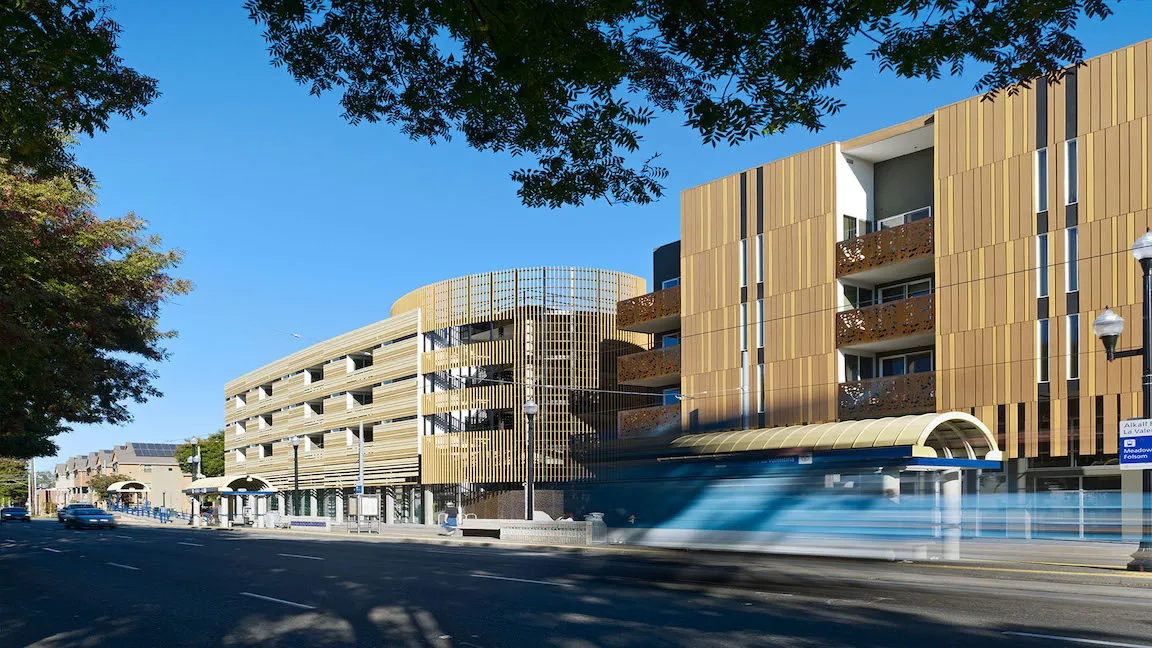
La Valentina Station, an affordable housing complex in Sacramento, was designed by David Baker Architects. It includes 63 units on top of service and retail spaces along 12 Street.
Across the street from one another in San Francisco, David Baker Architects created two housing complexes that are indistinguishable — at least from exterior view.
One is 388 Fulton, with its units commanding up to $1 million each. The other is Richardson Apartments, providing supportive housing to people formerly experiencing homelessness, and demonstrating how the firm has rethought housing for people with low incomes, according to the firm’s new book, 9 Ways to Make Housing for People.
“With its strong geometric forms, unabashed use of color and texture, high-quality materials, and private green spaces, it puts to rest the common though misguided theory that affordable housing should look affordable,” notes a foreword for the book, written by Allison Arieff, editorial director of print for MIT Technology Review.
In late February, the firm’s founder, David Baker, and one of its principals, Caroline Souza, gave a presentation on their book to about 50 people at the Warehouse Artist Lofts in Sacramento. They spoke as part of the desigNarrative Speaker Series for the Central Valley chapter of the American Institute of Architects, or AIA.
In a city that continues to be gripped by an affordable housing crisis, the message Baker and Souza were sharing from their firm’s book is one that could be useful: that stylish and convivial affordable housing can be built to serve its residents and surrounding areas.
Souza and Baker broke down the nine strategies they have outlined. These include putting premium design elements — as simple as showy front doors — in shared spaces of buildings, orienting the buildings in unusual angles, and having art available for all residents and visitors to enjoy.
“We try to put the uses that people share together so that they run into each other and socialize,” Baker said during the presentation.
Souza also told the crowd that bringing light and fresh air into buildings encouraged people to move through areas and “also stays off that long, windowless corridor from ‘The Shining’ effect.”
Baker’s firm has offices in San Francisco, Oakland and Birmingham, Ala. and has done work locally, such as the La Valentina Station, a 63-unit project with Domus Development and landscape architect Fletcher Studio that was completed at a formerly toxic site along 12th Street in Sacramento in 2012.
Baker’s firm also did Rivermark in West Sacramento with BRIDGE Housing and Fletcher Studio, which was completed in 2015.
Baker and Souza spoke to a room that included some influential people in local housing efforts, such as Bruce Monighan, urban design manager for the City of Sacramento. Monighan said he and Baker are similarly minded.
“I have advocated for years that architecture should be about places for people,” Monighan said. “He’s very much aligned with that and less of a distinction of who the people are. But the places should be creative and supportive of people and their families and the diversity within those families.”
Paul Schmidt, a retired executive director for the Capitol Area Development Authority, said he thought the night’s event was outstanding.
“David Baker’s done more affordable housing than anybody in California,” Schmidt said. “And really the best designs for affordable housing. He’s sensitive to community use. Bicycle advocate. He’s a seasoned advocate for energy conservation and he’s been a leader.”
Dustin Littrell, design review administrator for Sacramento County within the planning environmental review section, said he’s a “big fan” of the firm’s work and they can be influential in getting multifamily housing built.
“I think they can help inspire those individuals bringing those projects forward, so we get these really beautiful structures,” Littrell said.
Baker said after the event that he was encouraged by the night’s turnout, which included a number of students along with the professional crowd.
“I think the planners and a lot of people really like this because it gives them a pattern that is understandable and direct that can make a difference,” Baker said. “Ideas like, ‘Well, let’s make the front door really nice’ … that’s not a deep, intellectual idea, but it’s really important.”
Souza expressed hope following the event about what her firm’s book can do.
“It’s not just pretty pictures for architects,” Souza said. “It really is intended to be useful to clients, planners, city agencies, community activists to think through regardless of style what is important in a building and what really makes it a good citizen in the urban fabric.”
View the full article: Expert architects present new book in Sacramento on how to build better affordable housing in Sacramento News & Review.